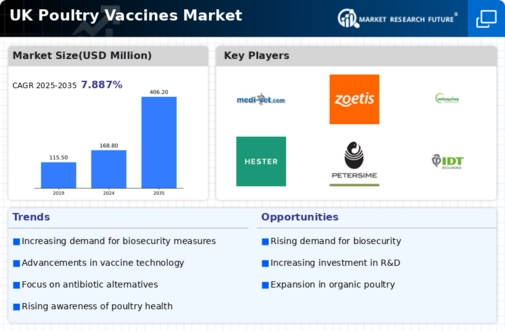Rising Demand for Poultry Products
The increasing demand for poultry products in the UK is a primary driver for the poultry vaccines market. As consumer preferences shift towards protein-rich diets, the poultry sector experiences significant growth. In 2025, the UK poultry meat consumption is projected to reach approximately 2.5 million tonnes, indicating a robust market for poultry products. This surge in demand necessitates enhanced biosecurity measures and vaccination programs to ensure the health of poultry flocks. Consequently, poultry producers are likely to invest in vaccines to prevent outbreaks of diseases, thereby supporting the growth of the poultry vaccines market. The need for maintaining high production levels while ensuring animal welfare further emphasizes the importance of effective vaccination strategies in the industry.
Regulatory Compliance and Standards
The poultry vaccines market is significantly influenced by stringent regulatory frameworks and compliance standards in the UK. The government and veterinary authorities enforce regulations to ensure the safety and efficacy of vaccines used in poultry farming. Compliance with these regulations is essential for poultry producers to maintain their operational licenses and market access. In 2025, the UK government is expected to enhance its focus on animal health regulations, which may lead to increased investments in vaccination programs. This regulatory environment compels poultry producers to adopt advanced vaccines that meet safety standards, thereby driving the growth of the poultry vaccines market. The emphasis on compliance not only protects animal health but also safeguards public health, reinforcing the critical role of vaccines in the industry.
Increased Awareness of Animal Health
The growing awareness of animal health and welfare among consumers and producers is a significant driver for the poultry vaccines market. In the UK, there is a rising concern regarding the impact of diseases on poultry populations and the subsequent effects on food safety. This awareness has led to a greater emphasis on preventive measures, including vaccination programs. In 2025, it is estimated that around 70% of poultry producers will prioritize vaccination as a key strategy for disease management. This shift in focus not only enhances the health of poultry flocks but also aligns with consumer expectations for ethically produced food. As a result, the poultry vaccines market is likely to experience sustained growth, driven by the increasing commitment to animal welfare and health.
Economic Factors Influencing Production Costs
Economic factors play a crucial role in shaping the poultry vaccines market. Fluctuations in feed prices, labour costs, and overall production expenses can significantly impact the profitability of poultry farming in the UK. In 2025, it is projected that feed costs will account for approximately 60% of total production expenses for poultry producers. As a response to rising costs, producers are likely to invest in vaccines to prevent disease outbreaks that could lead to substantial financial losses. By ensuring flock health through vaccination, poultry producers can mitigate risks and enhance productivity, ultimately supporting the growth of the poultry vaccines market. The interplay between economic conditions and vaccination strategies underscores the importance of vaccines in maintaining a sustainable poultry industry.
Technological Advancements in Vaccine Development
Technological advancements in vaccine development are reshaping the poultry vaccines market. Innovations such as recombinant vaccines and vector-based vaccines are gaining traction among poultry producers in the UK. These advanced vaccines offer improved efficacy and safety profiles, addressing the challenges posed by traditional vaccination methods. In 2025, the market for innovative vaccine technologies is anticipated to grow by approximately 15%, reflecting the industry's shift towards more effective solutions. The adoption of these technologies enables poultry producers to enhance flock health and productivity, ultimately leading to increased profitability. As the poultry vaccines market evolves, the integration of cutting-edge technologies is likely to play a pivotal role in meeting the demands of modern poultry farming.





















Leave a Comment